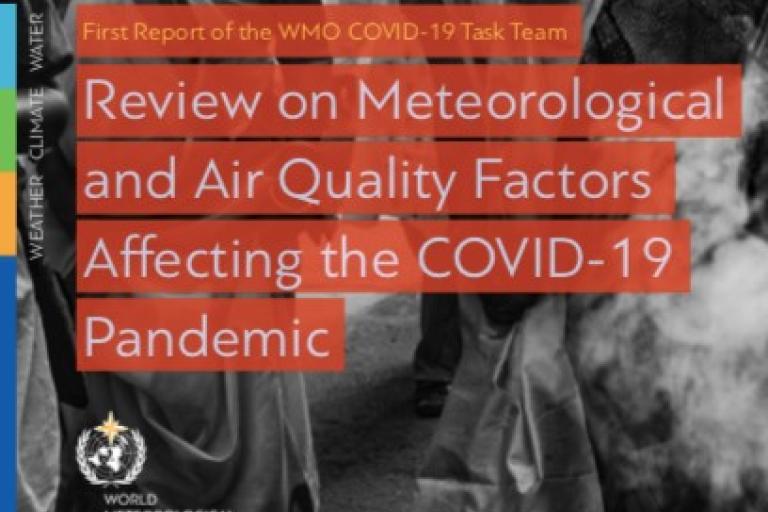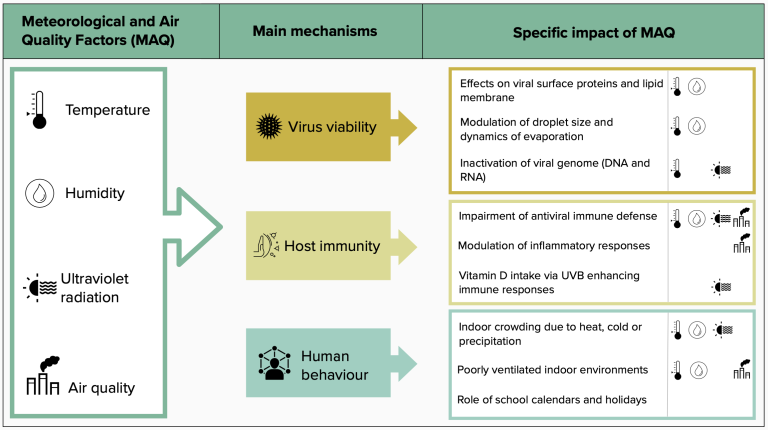Report examines meteorological and air quality factors and COVID-19
A World Meteorological Organization Task Team has issued its first report on Meteorological and Air Quality factors affecting the COVID-19 pandemic. It cautions that weather and climate conditions, including the onset of higher temperatures in the northern hemisphere spring, should not be used as a trigger to relax measures to halt the spread of the virus.

Government interventions rather than meteorological factors primarily curb COVID-19 spread
Preliminary report suggests climate conditions should not be used as a trigger to relax control measures
Geneva, 18 March 2021 - A World Meteorological Organization Task Team has issued its first report on Meteorological and Air Quality factors affecting the COVID-19 pandemic. It cautions that weather and climate conditions, including the onset of higher temperatures in the northern hemisphere spring, should not be used as a trigger to relax measures to halt the spread of the virus.
COVID-19 transmission dynamics in 2020 and early 2021 appear to have been influenced primarily by government interventions such as mask mandates and travel restrictions rather than meteorological factors, according to the 16-member panel of experts in earth and medical sciences and public health. Other relevant drivers include changes in human behavior and demographics of affected populations, and more recently, virus mutations.
“At this stage, evidence does not support the use of meteorological and air quality factors as a basis for governments to relax their interventions aimed at reducing transmission,” said Task Team Co-chair, Dr Ben Zaitchik, Department of Earth & Planetary Sciences, Johns Hopkins University, Baltimore, USA. “We saw waves of infection rise in warm seasons and warm regions in the first year of the pandemic, and there is no evidence that this couldn’t happen again in the coming year.”
The Task Team report provides a summary of key findings published by the first week of January 2021. It therefore does not include peer-reviewed literature regarding the influence of meteorological and air quality factors on transmission of the new strains of the COVID-19 virus, or on severity of infections caused by these new strains.
The report looks at the potential role of seasonality. Respiratory viral infections frequently show some form of seasonality, in particular the autumn-winter peak for influenza and cold-causing coronaviruses in temperate climates. This has fueled expectations that, if it persists for many years, COVID-19 will prove to be a strongly seasonal disease.
“The underlying mechanisms that drive seasonality of respiratory viral infections are not yet well understood. A combination of direct impacts on virus survival, impacts on human resistance to infection, and indirect influence of weather and season via changes in human behavior may be at work,” says the report’s executive summary.
“Laboratory studies of SARS-CoV-2, the virus that causes COVID-19, have yielded some evidence that the virus survives longer under cold, dry, and low ultraviolet radiation conditions. However, these studies have not yet indicated if direct meteorological influences on the virus have a meaningful influence on transmission rates under real world conditions,” according to the executive summary.
Evidence on the influence of air quality factors is still inconclusive. There is some preliminary evidence that poor air quality increases COVID-19 mortality rates, but not that pollution directly impacts airborne transmission of SARS-CoV-2, the virus that causes COVID-19, according to the Task Team.
The report focuses on outdoor meteorology and air quality conditions and does not address details of indoor air circulation.
The interdisciplinary and international Task Team was established by WMO’s Research Board in order to provide a rapid summary of the state of knowledge regarding potential meteorological and air quality influences on COVID-19 dynamics, given the staggering number of papers and pre-prints currently available.
“The rapid pace of COVID-19 research has meant that studies with limited data appeared faster than the information could be cross-checked and peer-reviewed. It soon became clear that reported evidence was often contradictory or selective due to methodological and data-related shortcomings. The WMO Task Team therefore seeks to encourage good practice in research and communications,” says Prof. Juerg Luterbacher, Director, Science & Innovation, and WMO Chief Scientist.
Future work of the Task Team will include the update of the scientific evidence over the next months, the identification and promotion of a structured set of priority research questions, objectives and priorities for research investment in the areas of the pandemics – weather – climate-air quality nexus.
The Task Team will also advise and inform on good practices and minimum standards for methods for integrated infectious disease modelling considering environmental determinants, and recommend on how the coronavirus, climate, weather and air quality nexus should be factored in to research and information delivery in future WMO activities.

Examples of proposed mechanisms through which Meteorological and Air Quality
factors influence respiratory viral infections.
Executive Summary:
- Epidemiological studies of COVID-19 have, to date, offered mixed results regarding the meteorological sensitivity of the virus and the disease.
- COVID-19 transmission dynamics in 2020 appear to have been controlled primarily by government interventions rather than meteorological factors. Other relevant drivers include changes in human behavior and demographics of affected populations, and more recently, virus mutations.
- Respiratory viral infections frequently exhibit some form of seasonality, particularly in temperate climates. The seasonality in respiratory viral diseases--in particular the autumn-winter peak for influenza and cold-causing coronaviruses in temperate climates--has fueled expectations that COVID-19 will prove to be a strongly seasonal disease should it persist for multiple years (see figure).
- The underlying mechanisms that drive seasonality of respiratory viral infections are not yet well understood. A combination of direct impacts on virus survival, impacts on human resistance to infection, and indirect influence of weather and season via changes in human behavior may be at work (Figure 1).
- Laboratory studies of SARS-CoV-2, the virus that causes COVID-19, have yielded some evidence that the virus survives longer under cold, dry, and low ultraviolet radiation conditions. However, these studies have not yet indicated if direct meteorological influences on the virus have a meaningful influence on transmission rates under real world conditions.
- There is evidence that chronic and short-term exposure to air pollution exacerbates symptoms and increases mortality rates for some respiratory diseases. This is consistent with early studies of COVID-19 mortality rates, but these results need to be confirmed and consolidated by controlling for individual-level risk factors. There is no direct, peer reviewed evidence of pollution impacts on the airborne viability of SARS-CoV-2 at this time.
- Process-based modeling studies anticipate that COVID-19 transmission may become seasonal over time, suggesting Meteorology and Air Quality (MAQ) factors may support monitoring and forecasting of COVID-19 in the coming months and years.
- At this stage, however, evidence does not support the use of MAQ factors as a basis for governments to relax their interventions aimed at reducing transmission.
- Research quantifying links between MAQ factors and COVID-19 is needed. It is critical that modelling studies properly account for confounding factors, consider both direct and indirect MAQ effects, address limitations in the COVID-19 data record, report uncertainty ranges, evaluate predictive skill, and apply appropriate statistical or process-based modelling techniques.
- The availability of open, timely, and quality controlled data on COVID-19 and associated risk factors is critical for studies of MAQ influence, and for many other studies of COVID-19 risk. Efforts to provide these data have been disjointed, and point to the need for a reporting infrastructure that supports data management and dissemination for analysis of epidemic diseases.
- Peer-reviewed studies have the potential to influence public health decisions and public perceptions of disease risk. For this reason, it is critical that researchers, publishers, and information providers maintain high standards for analysis and evaluation of emerging studies.
- Just as importantly, clear and active communication between researchers, the media, and decision makers is required to ensure that scientific findings are applied to policy in an appropriate, objective, transparent and responsible manner.
Notes to Editors
Task Team Members:
- Rosa Barciela, UK Met Office, Exeter, United Kingdom
- Emily YY Chan, The Jockey Club School of Public Health and Primary Care, Hong Kong, People's Republic of China
- David Farrell, Caribbean Institute for Meteorology and Hydrology, Bridgetown, Barbados
- Yun Gao, Chinese Academy of Meteorological Science, China Meteorological Administration, Beijing, People's Republic of China
- Ken Takahashi Guevara, National Meteorology and Hydrology Service of Peru (SENAMHI), Lima, Peru
- Sophie Gumy, Department of Environment, Climate Change and Health, World Health Organization, Geneva, Switzerland
- Masahiro Hashizume, Graduate School of Medicine, University of Tokyo, Tokyo, Japan
- Rachel Lowe, London School of Hygiene and Tropical Medicine, London, United Kingdom
- Nick H. Ogden, Public Health Agency of Canada, Guelph, Ontario, Canada
- Judy Omumbo, African Academy of Sciences, Nairobi, Kenya
- Vincent-Henri Peuch, Director of the Copernicus Atmosphere Monitoring Service (CAMS) and Deputy Director of the Copernicus Department at ECMWF
- Xavier Rodó, Barcelona Institute for Global Health (ISGlobal), Spain.
- Paulo Saldiva, University of Sao Paulo, Faculty of Medicine (FMUSP), Sao Paulo, Brazil
- Juli Trtanj, NOAA Climate Programme Office, Washington DC, USA
- Ben Zaitchik, Johns Hopkins University, Baltimore, MD, USA
- Tong Zhu, College of Environmental Sciences and Engineering, Peking University, Beijing, People's Republic of China
The World Meteorological Organization (WMO) is a specialized agency of the United Nations responsible for promoting international cooperation in atmospheric science and meteorology.
WMO monitors weather, climate, and water resources and provides support to its Members in forecasting and disaster mitigation. The organization is committed to advancing scientific knowledge and improving public safety and well-being through its work.
For further information, please contact:
- Clare Nullis WMO media officer cnullis@wmo.int +41 79 709 13 97

